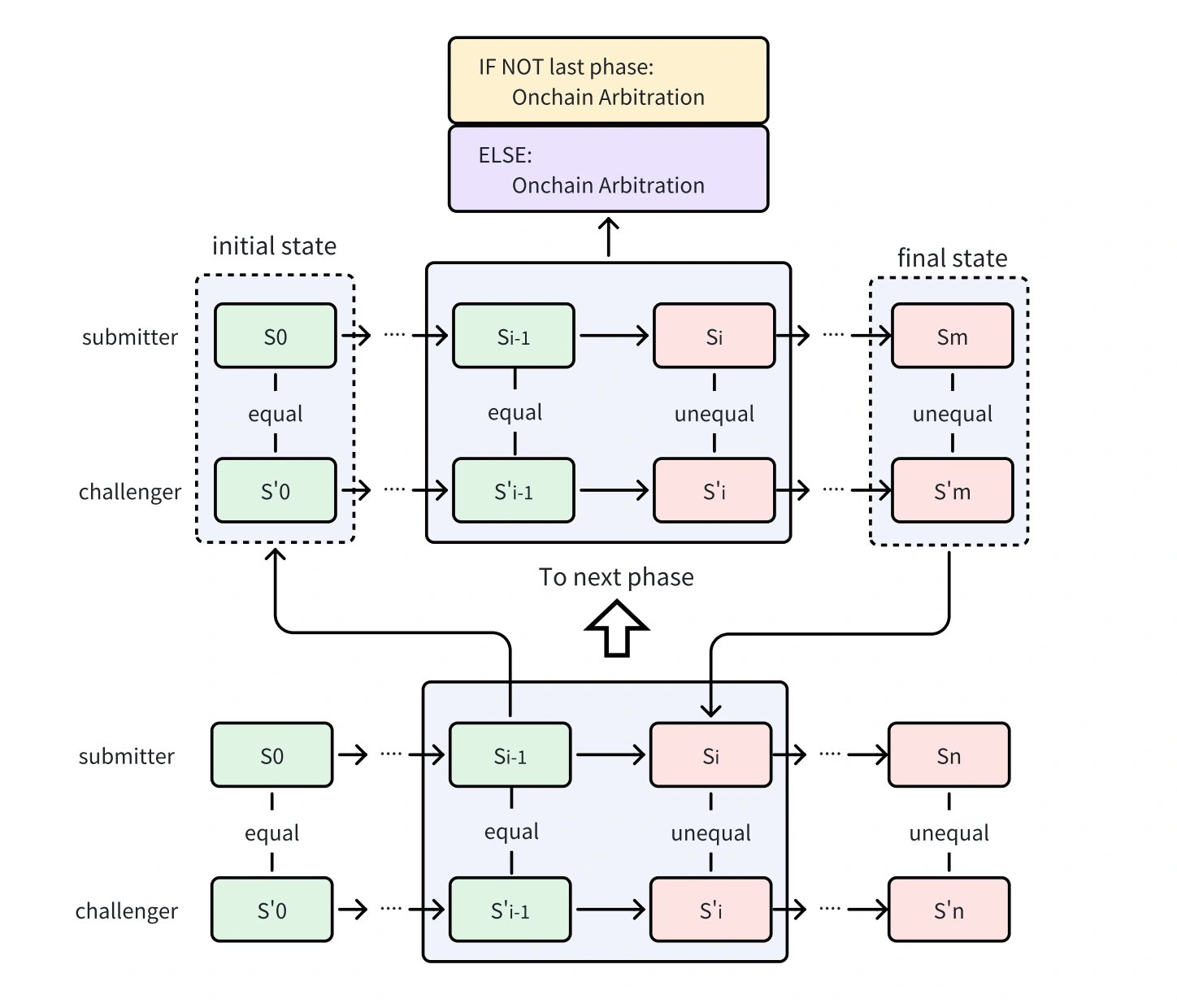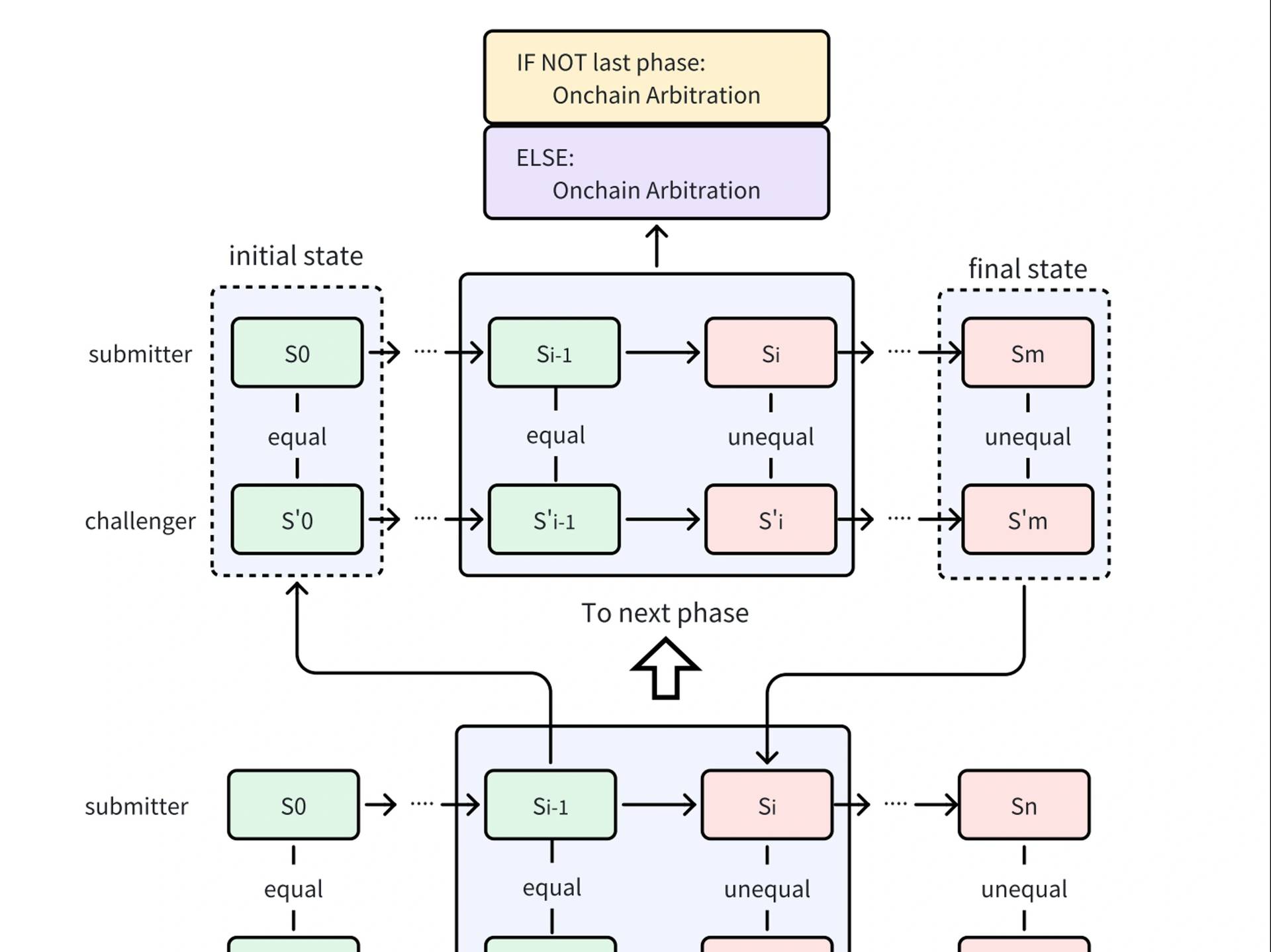위키 구독하기
Share wiki
Bookmark
opML
에이전트 토큰화 플랫폼 (ATP):에이전트 개발 키트(ADK)로 자율 에이전트 구축
opML
소개
opML(Optimistic Machine Learning)은 ORA에서 발명 및 개발한 것으로, 머신러닝과 블록체인 기술을 통합하는 획기적인 접근 방식을 제시합니다. 낙관적 롤업의 유사한 원리를 활용하여 opML은 분산 방식으로 계산의 유효성을 보장합니다. 이 프레임워크는 AI 계산의 온체인 검증을 허용함으로써 머신러닝 추론에 대한 투명성을 높이고 신뢰를 증진시킵니다. [1]
아키텍처
OpML은 다음과 같은 주요 구성 요소로 구성됩니다.
- 사기 증명 가상 머신(오프체인 VM): 머신러닝 추론을 실행하는 강력한 오프체인 엔진입니다. 이 구성 요소는 머신러닝 추론을 실행하고 출력으로 새로운 VM 상태를 생성합니다. 서로 다른 VM 상태로 나타나는 불일치가 발생하면 MIPS VM은 이분법을 사용하여 분기가 시작되는 정확한 단계 또는 명령어를 찾습니다.
- opML 스마트 계약(온체인 VM): 오프체인 계산의 정확성을 보장하기 위해 계산 결과의 검증에 사용됩니다. 이러한 계약을 통해 단일 MIPS 명령어를 실행할 수 있으므로 온체인 환경에서 계산 프로세스의 특정 단계를 검증할 수 있습니다. 이 기능은 분쟁 해결과 오프체인 계산의 무결성 보장에 매우 중요합니다.
- 사기 증명: 분쟁이 발생하는 경우, 검증자가 생성한 사기 증명은 계산의 불일치를 보여주는 결정적인 증거 역할을 하며 opML 스마트 계약을 통해 해결 프로세스를 용이하게 합니다.
검증 게임
검증 게임은 두 명 이상의 당사자가 동일한 프로그램을 실행하는 것으로 가정하는 프로세스입니다. 그런 다음 당사자는 논쟁이 있는 단계를 찾기 위해 정확한 스타일로 서로에게 도전할 수 있습니다. 이 단계는 검증을 위해 스마트 계약으로 전송됩니다.
시스템이 의도한 대로 작동하려면 다음을 보장하는 것이 중요합니다.
- 결정적 ML 실행
opML은 고정 소수점 산술 및 소프트웨어 기반 부동 소수점을 사용하여 일관된 ML 실행을 보장하고, 무작위성을 제거하며 상태 전이 함수를 사용하여 결정적 결과를 얻습니다. - 증명과 분리된 실행
opML은 최적화된 네이티브 실행용 하나와 안전한 검증을 위한 사기 증명 VM 명령어용 다른 하나의 이중 컴파일 방법을 사용합니다. 이를 통해 빠른 실행과 안정적이고 기계 독립적인 증명을 모두 보장합니다. - VM에서 AI 모델 추론의 효율성
낙관적 롤업 시스템에서 널리 채택되는 기존의 사기 증명 시스템은 전체 계산을 사기 증명 VM 명령어로 크로스 컴파일해야 하며, 이는 비효율적인 실행과 막대한 메모리 소비로 이어집니다. opML은 반 네이티브 실행과 지연 로딩을 허용하는 새로운 다단계 프로토콜을 제안하여 사기 증명 프로세스 속도를 크게 향상시킵니다.
전체 opML 프로세스는 다음 단계를 포함합니다.
- 요청자는 먼저 ML 서비스 작업을 시작합니다.
- 서버는 ML 서비스 작업을 완료하고 결과를 체인에 커밋합니다.
- 검증자는 결과를 검증합니다. 결과가 잘못되었다고 선언하는 검증자가 있다고 가정합니다. 그것은 서버와 검증 게임(이분법 프로토콜)을 시작하고 구체적인 잘못된 단계를 지적하여 주장을 반박하려고 합니다.
- 마지막으로, 단일 단계에 대한 중재는 스마트 계약에서 수행됩니다.
다단계 검증 게임
계산 리소스를 더 잘 활용할 수 있도록 하는 단일 단계 검증 게임의 확장을 나타냅니다.
단일 단계 검증 게임은 전체 ML 추론 코드를 사기 증명 VM 명령어로 크로스 컴파일합니다. 이 방법은 네이티브 실행보다 효율성이 떨어집니다(GPU/TPU 가속 및 병렬 처리의 전체 잠재력을 활용하지 못함). 사기 증명 VM의 메모리도 제한되어 있어 대규모 모델을 메모리에 직접 로드할 수 없습니다.
위의 문제를 해결하기 위해 다단계 검증 게임은 다음과 같은 속성을 도입합니다.
- 반 네이티브 실행 다단계 설계를 통해 단일 단계 프로토콜과 유사하게 최종 단계에서만 VM에서 계산을 수행하면 됩니다. 다른 단계의 경우 CPU, GPU 또는 TPU의 병렬 처리 기능을 활용하여 네이티브 환경에서 상태 전이를 유도하는 계산을 수행할 수 있습니다. VM에 대한 의존성을 줄임으로써 오버헤드를 크게 줄여 opML의 실행 성능을 네이티브 환경과 거의 비슷하게 크게 향상시킵니다.
- 지연 로딩 설계 사기 증명 VM의 메모리 사용량과 성능을 최적화하기 위해 지연 로딩 기술을 구현합니다. 즉, 모든 데이터를 한 번에 VM 메모리에 로드하는 것이 아니라 각 데이터 항목을 식별하는 키만 로드합니다. VM이 특정 데이터 항목에 액세스해야 하는 경우 키를 사용하여 외부 소스에서 해당 항목을 가져와 메모리에 로드합니다. 데이터 항목이 더 이상 필요하지 않으면 메모리에서 스왑 아웃하여 다른 데이터 항목을 위한 공간을 확보합니다. 이렇게 하면 메모리 용량을 초과하거나 VM의 효율성을 저해하지 않고 많은 양의 데이터를 처리할 수 있습니다.

추가 자료
잘못된 내용이 있나요?
